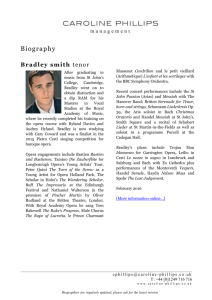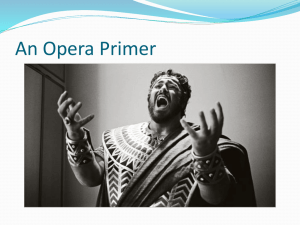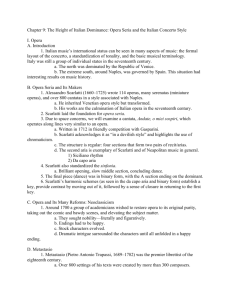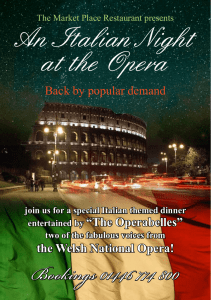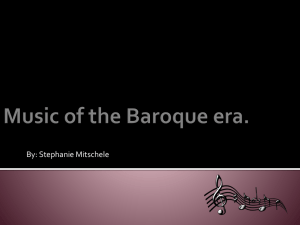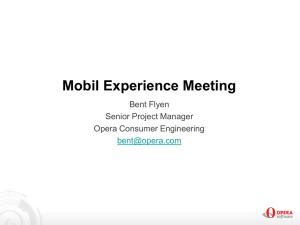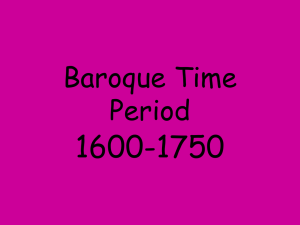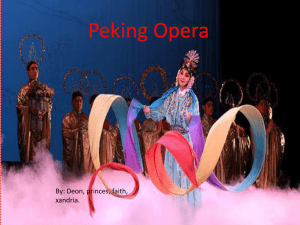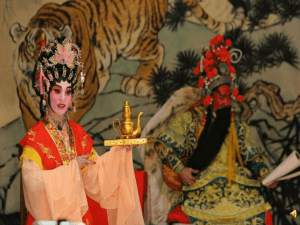Jean-Philippe Rameau
advertisement
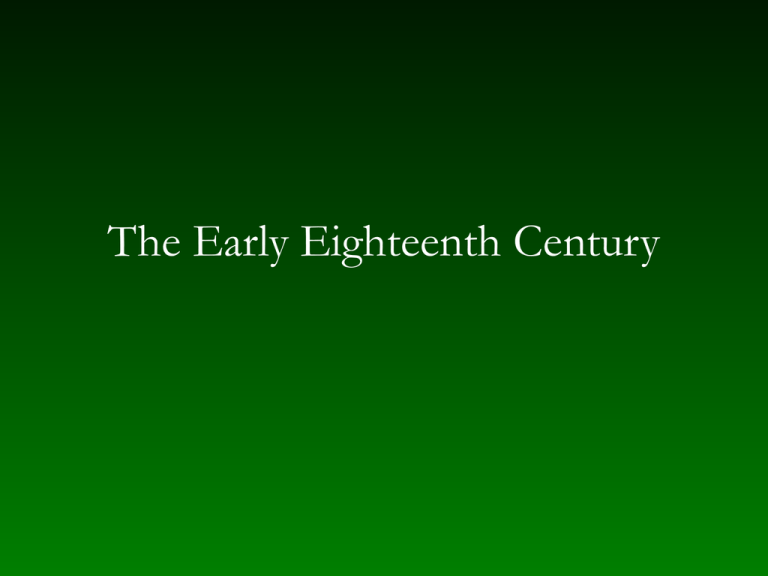
The Early Eighteenth Century Opera seria in the early eighteenth century • Addressed to aristocratic audience • Dramatic style — libretti brought to high level by Pietro Metastasio (1698–1782) – Rationalistic – three acts – dialogue in simple recitative alternating with affective/rhetorical arias generally in da capo form – characters allotted a number of arias according to carefully developed schemes of theatrical hierarchy – emphasis on solo arias rather than character interaction Intermezzo • Rationalist opera seria eliminated comic aspects • Comedic intermezzi performed between acts – plots adopted from popular commedia dell’arte — street theater – stock characters: clever, young woman (soprano) bests older, dominating man (bass) in “carnivalesque” social inversion • Two acts, corresponding to intermissions in opera seria • Simple recitatives, affective da capo arias and ensemble numbers • Accompaniment provided by reduced orchestra • Giovanni Battista Pergolesi (1710–1736) La serva padrona (1733) best known and most influential in music history George Frideric Handel (1685–1759) and the opera • Born in Halle, Germany, went to Hamburg to study music, played in opera under Reinhard Keiser (1674–1739) • At 21, went to Italy to develop his skills • Returned to Germany in 1710 as music director at the Elector’s court in Hanover • 1710–1711 season in London — Italian operas brought great success • Returned to Hanover but almost immediately went back to London, where he spent the rest of his career • 1714 Elector of Hanover became King George I of England • 1720–28 — Handel’s operas produced in honor of the king at the Royal Academy of Music • Altogether, Handel wrote forty operas Decline of Italian opera in England • Growing urban, commercial class disliked – unfamiliar mythological and classical plots – foreign language – castrati • Royal Academy of Music closed • Handel founded New Royal Academy, but it also failed – competed rival company Opera of the Nobility – drove both companies to the verge of bankruptcy Jean-Philippe Rameau (1683–1764) • Early career – keyboard pieces – established himself as a theorist — Traite de l’harmonie (1722) • At first unsuccessful in opera • Patronage of Alexandre-Jean-Joseph Le Riche de la Pouplinière — enabled success in opera – Hippolyte et Aricie (1733) – Les Indes galantes (1735) — opera-ballet • Guerre des Lullistes et des Ramistes — journalistic battle in 1730s – Lullistes claimed Rameau’s works abandoned true French style of Lully – Ramistes insisted that his music maintained Lullian ideals Handel and the oratorio • Reach to London’s urban audience – – – – English language familiar biblical subjects English choral tradition avoided artificialities of Italian opera, including castrati – – – – Saul, Israel in Egypt 1739 — established genre Messiah 1742 — biblical prose, not dramatic Judas Maccabeus 1746 Solomon 1749 – – – – three acts narrative recitatives and affective/rhetorical arias overtures in French style or sinfonias in Italian style more emphasis on chorus than in opera • English oratorios — twenty-six • Like opera in general musical resources Choruses in Handel’s oratorios • Chorus becomes hallmark of genre • Magnificent choral anthem style • More varied uses than opera (which hardly used chorus by this time) • commentary — expression of affect through musical rhetoric • action • narration • pictorialism — replaces visual aspects of opera staging • singability — from English anthem Johann Sebastian Bach (1685–1750) — earliest years • Musician family – born 21 March 1685 in Eisenach – parents died 1695, Bach lived with older brother in Ohrdruf • Chorister in Lüneburg — interest in the organ – met Georg Böhm (1661–1733) – visited Hamburg to hear Johann Adam Reinken (1623– 1722) Bach in his late teens and twenties • Arnstadt 1703–1707 and Mühlhausen 1707–1708 — church organist – toccatas, fugues, chorale-based works – earliest vocal sacred concertos (so-called church cantatas) • Weimar Duke’s chapel 1708–1717 – violinist — transcriptions of Italian instrumental works for organ – choral director — sacred concertos Bach in Cöthen 1717–1723 • Kapellmeister to Prince — mostly secular music – orchestral and chamber works — including Brandenburg concertos – some secular cantatas • Teacher for his sons — clavier music, including – Two-part Inventions and Three-part Sinfonias – Well-Tempered Clavier, Book 1 (compiled 1722) Bach in Leipzig 1723–1750 • Leipzig, St. Thomas church (and other churches) and school — church music director and teacher – – – – sacred concertos motets Masses Passions — several annual cycles • Collegium Musicum, connected with university — instrumental music • Late, paradigmatic works Bach’s plan for the Lutheran sacred concerto (church cantata) Before the sermon • Large chorus, usually based on a chorale proper to the day • Recitative and aria or duet After the sermon • Recitative and aria or duet • Homorhythmic setting of the chorale Questions for discussion • In what ways did different balances of influence among social classes affect music in England, France, Germany, and Italy in the early eighteenth century? • How were Bach’s and Handel’s responses to the public’s changing musical tastes different? • In what ways might it be possible to consider some music of the early eighteenth century mannerist? Does the term seem as appropriate for this period as for the late fourteenth or late sixteenth century? Why or why not?
